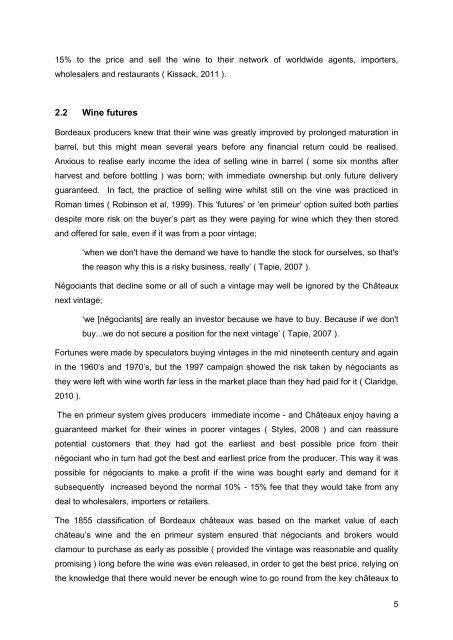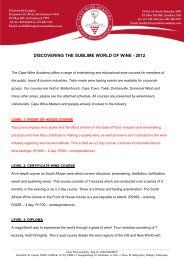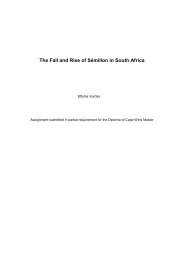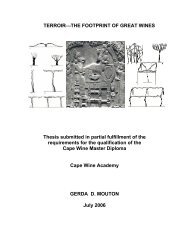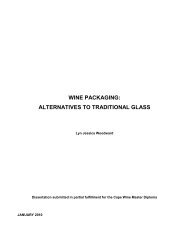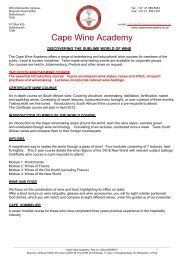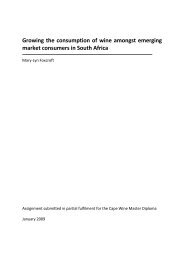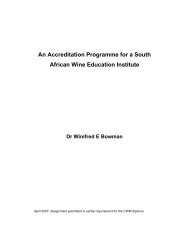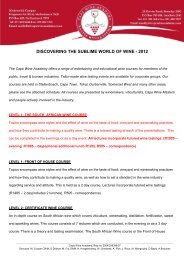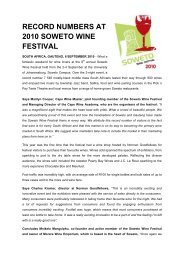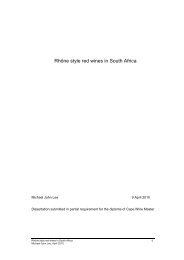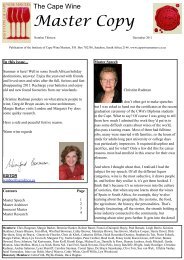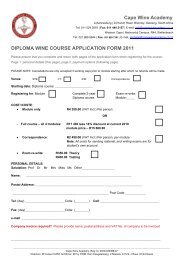Wine Investment in South Africa - Cape Wine Academy
Wine Investment in South Africa - Cape Wine Academy
Wine Investment in South Africa - Cape Wine Academy
You also want an ePaper? Increase the reach of your titles
YUMPU automatically turns print PDFs into web optimized ePapers that Google loves.
15% to the price and sell the w<strong>in</strong>e to their network of worldwide agents, importers,<br />
wholesalers and restaurants ( Kissack, 2011 ).<br />
2.2 <strong>W<strong>in</strong>e</strong> futures<br />
Bordeaux producers knew that their w<strong>in</strong>e was greatly improved by prolonged maturation <strong>in</strong><br />
barrel, but this might mean several years before any f<strong>in</strong>ancial return could be realised.<br />
Anxious to realise early <strong>in</strong>come the idea of sell<strong>in</strong>g w<strong>in</strong>e <strong>in</strong> barrel ( some six months after<br />
harvest and before bottl<strong>in</strong>g ) was born; with immediate ownership but only future delivery<br />
guaranteed. In fact, the practice of sell<strong>in</strong>g w<strong>in</strong>e whilst still on the v<strong>in</strong>e was practiced <strong>in</strong><br />
Roman times ( Rob<strong>in</strong>son et al, 1999). This ‘futures’ or ‘en primeur’ option suited both parties<br />
despite more risk on the buyer’s part as they were pay<strong>in</strong>g for w<strong>in</strong>e which they then stored<br />
and offered for sale, even if it was from a poor v<strong>in</strong>tage;<br />
‘when we don't have the demand we have to handle the stock for ourselves, so that's<br />
the reason why this is a risky bus<strong>in</strong>ess, really’ ( Tapie, 2007 ).<br />
Négociants that decl<strong>in</strong>e some or all of such a v<strong>in</strong>tage may well be ignored by the Châteaux<br />
next v<strong>in</strong>tage;<br />
‘we [négociants] are really an <strong>in</strong>vestor because we have to buy. Because if we don't<br />
buy...we do not secure a position for the next v<strong>in</strong>tage’ ( Tapie, 2007 ).<br />
Fortunes were made by speculators buy<strong>in</strong>g v<strong>in</strong>tages <strong>in</strong> the mid n<strong>in</strong>eteenth century and aga<strong>in</strong><br />
<strong>in</strong> the 1960’s and 1970’s, but the 1997 campaign showed the risk taken by négociants as<br />
they were left with w<strong>in</strong>e worth far less <strong>in</strong> the market place than they had paid for it ( Claridge,<br />
2010 ).<br />
The en primeur system gives producers immediate <strong>in</strong>come - and Châteaux enjoy hav<strong>in</strong>g a<br />
guaranteed market for their w<strong>in</strong>es <strong>in</strong> poorer v<strong>in</strong>tages ( Styles, 2008 ) and can reassure<br />
potential customers that they had got the earliest and best possible price from their<br />
négociant who <strong>in</strong> turn had got the best and earliest price from the producer. This way it was<br />
possible for négociants to make a profit if the w<strong>in</strong>e was bought early and demand for it<br />
subsequently <strong>in</strong>creased beyond the normal 10% - 15% fee that they would take from any<br />
deal to wholesalers, importers or retailers.<br />
The 1855 classification of Bordeaux châteaux was based on the market value of each<br />
château’s w<strong>in</strong>e and the en primeur system ensured that négociants and brokers would<br />
clamour to purchase as early as possible ( provided the v<strong>in</strong>tage was reasonable and quality<br />
promis<strong>in</strong>g ) long before the w<strong>in</strong>e was even released, <strong>in</strong> order to get the best price, rely<strong>in</strong>g on<br />
the knowledge that there would never be enough w<strong>in</strong>e to go round from the key châteaux to<br />
5


